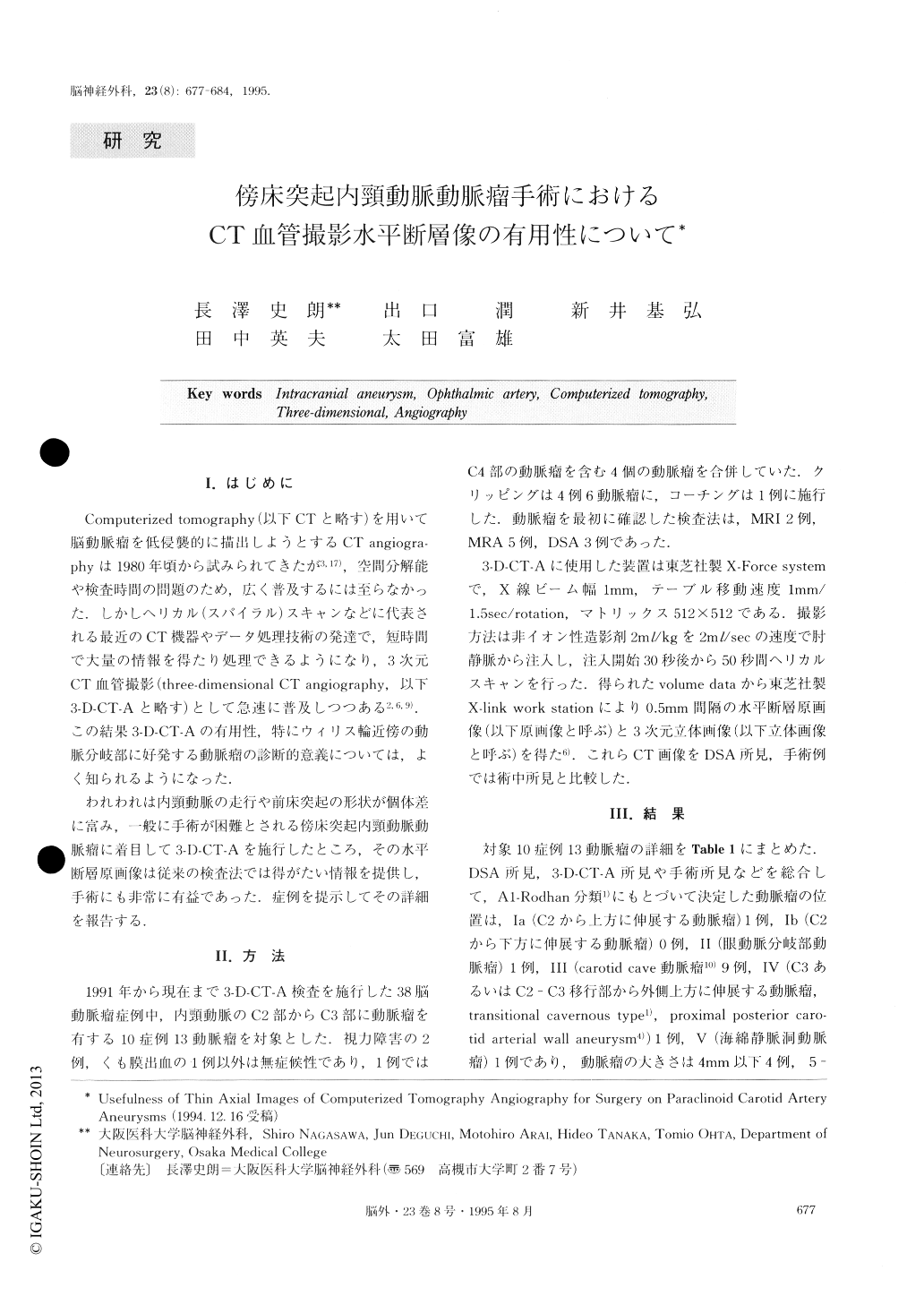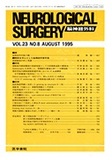Japanese
English
- 有料閲覧
- Abstract 文献概要
- 1ページ目 Look Inside
I.はじめに
Computerized tomography(以下CTと略す)を用いて脳動脈瘤を低侵襲的に描出しようとするCT angiogra—phyは1980年頃から試みられてきたが3,17),空間分解能や検査時間の問題のため,広く普及するには至らなかった.しかしヘリカル(スパイラル)スキャンなどに代表される最近のCT機器やデータ処理技術の発達で,短時間で大量の情報を得たり処理できるようになり,3次元CT血管撮影(three-dimensional CT angiography,以下3—D-CT-Aと略す)として急速に普及しつつある2,6,9).この結果3—D-CT-Aの有用性,特にウィリス輪近傍の動脈分岐部に好発する動脈瘤の診断的意義については,よく知られるようになった。
われわれは内頸動脈の走行や前床突起の形状が個体差に富み,一般に手術が困難とされる傍床突起内頸動脈動脈瘤に着目して3—D-CT-Aを施行したところ,その水平断層原画像は従来の検査法では得がたい情報を提供し,手術にも非常に有益であった.症例を提示してその詳細を報告する.
A number of surgical experiences with paraclinoid carotid artery aneurysms have been reported recently. However, neuroracliological examinations can not suffi-ciently visualize the topographic relations around the aneurysms due to variations in the size of the anterior clinoid process (ACP) or course of the carotid artery in individual cases. Although three-dimensional computer-ized tomography angiography (3-1)-CT-A) is known to be useful for the surgical management of cerebral aneurysms in common locations, its usefulness for para. clinoid carotid artery aneurysms has not been investi-gated. Ten cases involving a total of 13 aneurysms located in the clinoid portion of the carotid artery were in-cluded in this study according to Al-Radham's classi-fication (Table) . The CT scan used was an X Force system manufactured by Toshiba Electric Co, Japan. Non-ionic, iodinated contrast solution, a total of 2ml/ kg, was intravenously infused at a rate of 2ml/sec. Helical scanning was begun 30 seconds after initiating the infusion, 1mm pitch/1.5 second/rotation. 3-D im-ages and original images of axial slices were compared to conventional angiography, DSA and surgical find-ings.
The 3-1) images of 3-1)-CT-A was able to demon-strate both aneurysms located in the C2 segment of thecarotid artery (groups Ⅰ and Ⅱ), and five of nine caro-tid cave aneurysms (group Ⅲ). The aneurysms located more proximally (group Ⅳ or Ⅴ) could not be visual-ized. Original axial images of 3-D-CT-A, on the other hand, clearly demonstrated the C2, C3 and C4 segment of the carotid artery, dome and neck of the aneurysm and bone structures such as the anterior clinoid process (ACP) and sellae turcica in all cases.
3-D-CT-A is known to have several advantages in cases involving common locations around the Willis ring: multiple aneurysms on a single approach line, a giant aneurysm whose neck is not clearly demon-strated, or bony structures disturbing the access to aneurysms.
However, it has been generally regarded that 3-D-CT-A is of little value for diagnosing paraclinoid inter-nal carotid artery aneurysms. This study demonstrated that a series of original axial images of 3-D-CT-A pro-vides excellent information regarding surgical anatomy;each segment of the carotid artery, neck and dome of the aneurysm, the ACP and its topographic re-lations to the aneurysm, calcification, and so forth. Since aneurysms can be visualized even in the presence of clips applied to adjacent aneurysms, original images are useful for the follow-up of these specific untreated aneurysms.

Copyright © 1995, Igaku-Shoin Ltd. All rights reserved.


